
August is the time to plant the last of the autumn blooming flowers and start preparing for the blooming season that follows. The most beautiful and popular specimens can be found here.
In a nutshell
- Selection of numerous varieties for beds and balcony tubs
- many varieties need protection from the cold
- Flowering often into November
- all mentioned flower examples perennial
Table of contents
- Flowers for the garden bed
- balcony flowers
- frequently asked Questions
Flowers for the garden bed
The following flowers, which you can still plant in August, thrive best in a garden bed with the appropriate space:
Bearded Beard (Caryopteris x clandonensis)
A real eye-catcher is the bearded beard, which also blooms into November if planted in August. It is also because of its lush flowers particularly popular with insects.
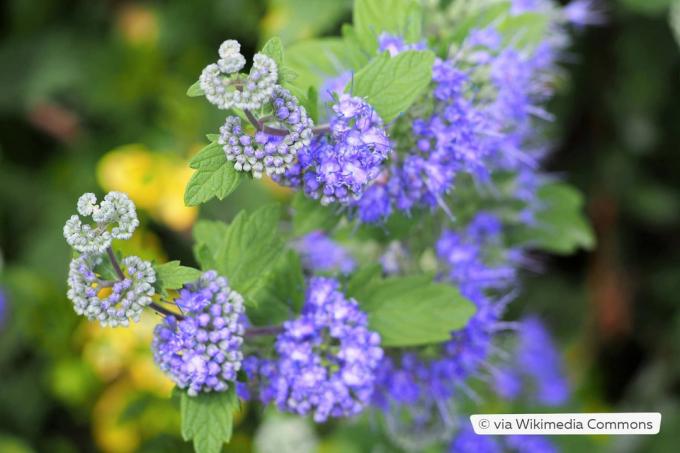
Source: Agnieszka Kwiecień, Nova, Caryopteris x clandonensis 'Heavenly Blue' 2016-09-04 03, Edited from Plantopedia, CC BY-SA 4.0
- Growth: semi-shrub; upright; dense; 60 to 80 cm
- flower: deep blue; End of June until first frost
- location: sunny; sheltered from the wind
- Variety: Kew Blue
- Special features: silvery-grey shoots; robust; hardy with sufficient protection against the cold
Penstemon (Penstemon fruticosus)
Among the robust, hardy specimens that can still be planted in August, there are only two varieties of barbel beard. However, these inspire with their willingness to bloom and ease of care.

- Growth: upright; slightly bushy; 30 to 40 cm
- Flower: pink or azure-violet; trumpet-shaped; June to October
- Location: sunny
- Varieties: Praecox Nanus Rondo and Catherine de la Mere
- Special features: clean withered flowers; evergreen; hardy
Dusky blue nettle (Agastache rugosa hybrid)
The dark blue nettle sets an intensive color accent in every garden and can also thrive in a bucket on the balcony. You should plant the flower in early August so that the heat will set it up quickly and continue blooming into November.
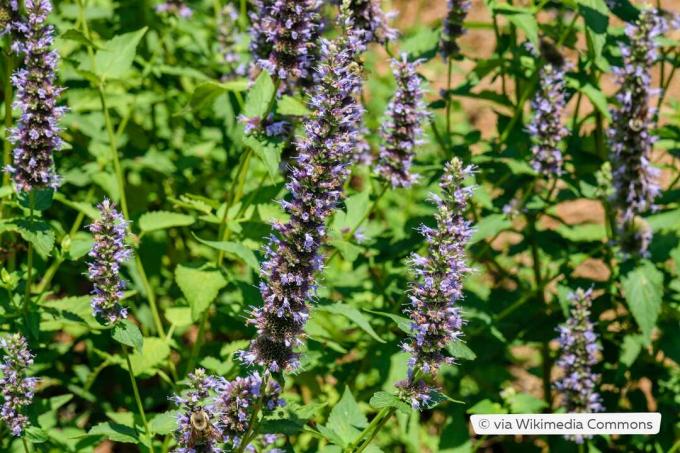
Source: PumpkinSky, Giant Hyssop NBG LR, Edited from Plantopedia, CC BY-SA 4.0
- Growth: upright; 80 to 120 cm
- Blossom: blue-violet, partly appearing black; dark cobs; August to November
- Location: sunny
- Varieties: Black Adder
- Special features: discreetly scented; bee friendly; extremely hardy
Goldhair Aster (Aster linosyris)
The golden-haired aster enchants every bed with its golden-yellow flowers, which are stylishly integrated into the typical autumn colors. Due to the shallow growing roots, they are also ideal for roof garden planting.
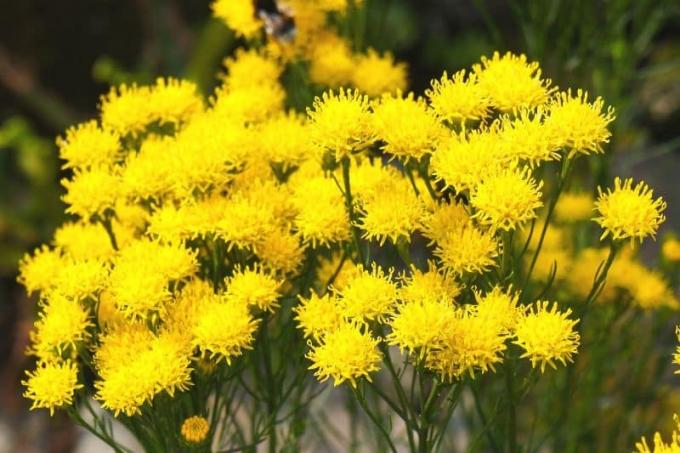
- Growth: upright; clump-forming; 40 to 60 cm
- flower: golden yellow; umbellate; June to November
- Location: sunny
- Varieties: Golden Dust
- Special features: very hardy; decorative wool seeds until late winter; deciduous; Tub cultivation not recommended
Ringworm (Chrysogonum virginianum)
The gold basket is particularly popular because it is a high insect and in particular bee-friendliness as well as an extremely long flowering period, which lasts continuously until autumn. There is hardly a carpet flower that blooms more luxuriantly.

- Growth: cushion-forming; clumpy; slightly bushy; 10 to 30 cm
- flower: deep yellow; radial; May to November
- Location: sunny
- Varieties: Andre Viette
- Special features: evergreen; easy-care; decorative all year round
Mexican Fleabane (Erigeron karvinskianus)
Also known as "Spanish Fleabane", it presents itself with breathtaking flowers not only for the garden, but also for balcony boxes and tubs. Plenty of heat is important for flowering.
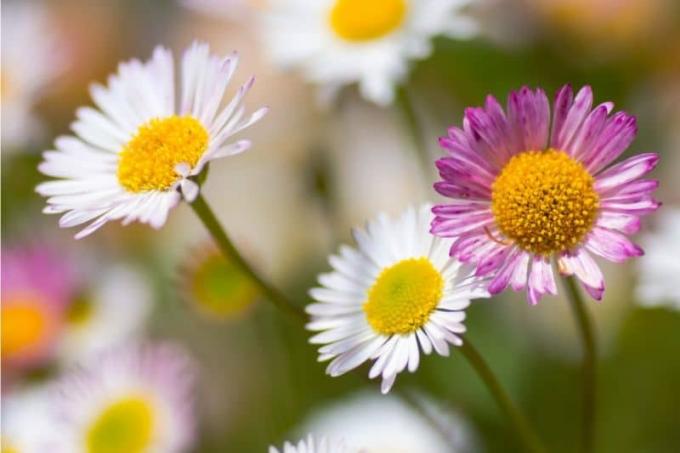
- Growth: ground covering; dense; rampant 20 to 30 cm
- flower: white, later pink; between June and first frost
- Location: full sun to sunny
- Varieties: sea of flowers
- Special features: hardy to a maximum of minus 12 degrees Celsius; ideal for planting in stone joints; usually freezes back in winter
Purple bells (Heuchera hybrid)
The purple bell is one of the most beautiful blooming flowers. Single-colored specimens are considered the less sensitive, which still produce lush flowers even in the shade.

Source: Photo by David J. rod, Heuchera Mocha 0zz, Edited from Plantopedia, CC BY-SA 4.0
- Growth: 30 to 50 cm
- Flower: white, pink, purple; bell-shaped; Late August to early November
- Location: sunny to shady
- Varieties: Mocha; Gracillima; Red Spangles; silver rain
- Special features: decorative ornamental leaves even in winter; hardy; Cold protection recommended in rough conditions
Tip: You can plant the purple bells throughout the summer. However, if you want to enjoy a long flowering period until November, the planting time should be at the beginning of August at the latest.
Cranesbill (Geranium hybrid)
The cranesbill can be planted in August without any problems and still blooms until the first frost. It is also very decorative as a traffic light plant on terraces and balconies.

Source: Dominicus Johannes Bergsma, Geranium 'Rozanne', Edited from Plantopedia, CC BY-SA 3.0
- Growth: 30 to 60 cm
- Flowers: violet with a white "eye", pink or white; May to November
- Location: sunny to off-sun
- Varieties: mainly hybrids such as "Rozanne"
- Special features: hardy; cold protection advised in the bucket; bee friendly; evergreen
Carpet myrtle aster (Aster ericoides var. pansus)
This flower is similar to daisies in that it has equally delicate flowers, grows flat, and spreads across walls and floors. But they also fill the surroundings with lively color in traffic lights and balcony boxes.

Source: Photo by David J. rod, Symphyotrichum ericoides var. ericoides snow grid 1zz, Edited from Plantopedia, CC BY-SA 4.0
- Growth: creeping; hanging; dense; 20 to 30 cm
- flower: white-yellow; September to November
- Location: sunny
- Varieties: Snow Flurry
- Special features: very robust and hardy; usually freezes back in winter
balcony flowers
If you don't have a garden, the colorful planting doesn't stop in August. There are particularly beautiful specimens that are then planted and the balcony in autumn can enchant.
Begonias (Begonia)
Begonias are among the classic balcony plants. The varieties for the balcony are ideal for pot, tub and hanging basket cultivation and can still be planted in August despite existing flowering from June/July.
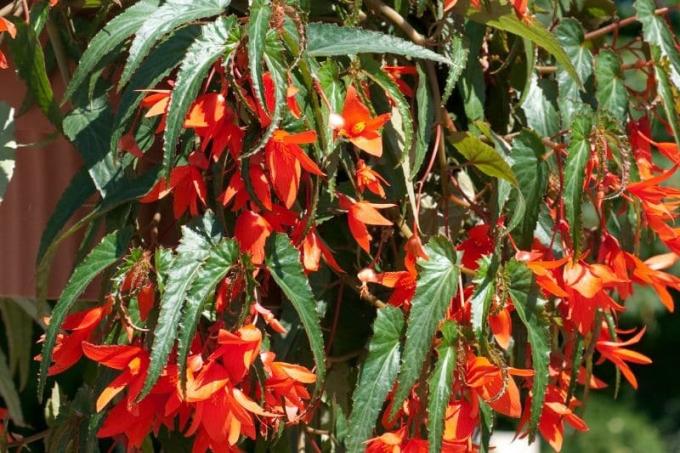
- Growth: upright or hanging, depending on the variety; 20 to 60 cm
- Flower: white, pink, orange-red, yellow; until November
- Location: partially shaded to shaded; no direct midday sun
- Varieties: Bonfire; Alba; Red Undies
- Special features: in mild regions in a sheltered location and hardy with protection against the cold
Tip: When choosing a balcony begonia, always pay attention to how it grows. Some, such as the "Alba" variety, only thrive upright as a young plant and only appear to be hanging with increasing age.
Autumn cyclamen (Cyclamen hederifolium)
The Cyclamen is widely used as a houseplant and many do not know that there are also special varieties for outdoors, especially in autumn. There they can even spend the whole winter and bring color to the dark autumn and winter days with their evergreen foliage.

Source: Agnes Monkelban, Cyclamen hederifolium 013, Edited from Plantopedia, CC BY-SA 4.0
- growth: flat; spread out clumpy to loose clumpy; 10 to 20 cm
- flower: white or pink; September to November
- Location: partially shaded; tolerates sun
- Varieties: Album; Amaze Me Pink; Amaze Me White
- Special features: hardy between minus 20 and minus 25 degrees Celsius; evergreen; Leaves shimmer silver all year round
Autumn chrysanthemums (Chrysanthemum indicum hybrid)
Autumn chrysanthemums should be planted in August or September so that they bloom magnificently that same year. They offer a diverse selection of varieties in a wide variety of colors.

- Growth: upright; 50 to 120 cm
- Flowers: yellow, ruby red, creamy white; basket-like; September to November/December, depending on the variety
- Location: sunny
- Variety: Autumn Ruby; Poetry; bee
- Special features: hardy to minus 10 degrees Celsius
Tip: So that the late-blooming autumn chrysanthemums can develop well until they bloom, purchased pot specimens should be used definitely removed from the pots and repotted in larger containers with a high-quality, very nutrient-rich substrate become.
Hydrangeas (Hydrangea)
Hydrangeas can be planted from spring after the last late frost until August at the latest to avoid the risk of not being able to establish themselves well enough until winter. Flower lovers still benefit from the blossom until September, but if one already flowering specimen is planted, but the full bloom is then only in the following year admire.

Source: Photo by David J. rod, Hydrangea macrophylla Endless Summer 3zz, Edited from Plantopedia, CC BY-SA 4.0
- Growth: upright; tight drive; shrubby; in tubs up to 150 cm
- Flower: whitish-pink, pink, blue-violet, blue; May until October
- Location: sunny to semi-shady
- Sorts: Endless Summer; Forever & Ever; everbloom; vanilla fraise; Sundae Fraise; Pinky Winky
- Special features: also suitable for garden planting; hardy; Potted plants need protection from the cold; evergreen
Daylily (Hemerocallis)
Daylilies are very long-lived, adaptable and easy-care flowers. While the "regular" varieties feel more at home in the garden bed due to their wide growth, the exotic varieties, like the two example varieties, are better for balcony planting.

- Growth: upright; 50 to 80 cm in height
- flower: crimson; apricot; pink, yellow; depending on the variety until October
- Location: sunny or semi-shady; sheltered from the wind
- Varieties: Crimson Pirate; Doc Holiday
- Special features: hardy; insect friendly; edible petals
frequently asked Questions
Vegetables with a short growing season can be planted in August, such as lamb's lettuce, kohlrabi, chard, spinach as well as radishes. Also some winter vegetables such as winter leeks and kale can be sown in August, as well as herbs such as coriander, rosemary, thyme, basil and dill are planted. The same applies to fruit bushes such as blueberries, currants, once-bearing strawberries and hybrid varieties of blackberries. For grasses such as alang grass, variegated sedge and red lamp cleaning grasses The planting season begins in August.
If you want to sow flowers for the following year, August is the ideal month for seeds such as silk poppies, corn and bluebells as well as stinging nettles and gold lacquer.
August often brings very hot and dry days. Therefore, when planting in this month, particular attention must be paid to sufficient soil moisture. Especially with flowering specimens, the water requirement increases significantly during the flowering period and drought could bring this to a premature end.
